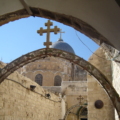The Sanctuary of Guadalupe is a cornerstone of Mexican and American culture. Each year, from December 6 to 12, nearly 12 million people visit this iconic site, drawn by its deep cultural and spiritual significance. For many, the journey itself is as meaningful as the destination, and two routes, in particular, stand out for their historical and cultural importance: the Calzada de Guadalupe and the Calzada de los Misterios.
The Calzada de Guadalupe: A Living Pathway
Stretching nearly 5 kilometers, the Calzada de Guadalupe links the Glorieta de Peralvillo to the Plaza de las Américas, right in front of the Basilica of Guadalupe. Designed for both vehicular and pedestrian use, its wide central promenade is adorned with gardens, benches, and a 5-meter-wide walkway that welcomes thousands of pilgrims every year.
More than just a religious artery, this route offers a unique opportunity to explore architectural and cultural landmarks. Since its construction in the late 18th century, it has served as a bridge between pre-Hispanic traditions and modern spirituality.
Shared History: The Connection to the Calzada de los Misterios
The Calzada de Guadalupe was built between 1786 and 1791 as an alternative to the Calzada de los Misterios, an older route with roots in the Mexica period. Originally, the Calzada de los Misterios connected Tenochtitlán (modern-day Mexico City) to the town of Tepeyacac, where ceremonies were held in honor of Tonantzin, the mother of the gods in Mexica mythology.
With the arrival of the Spanish and the reported apparitions of the Virgin of Guadalupe in 1531, the spiritual significance of Tepeyac shifted. The site became a cornerstone of Christian devotion in Mexico. In the 17th century, the Calzada de los Misterios was adorned with 15 Baroque monuments known as “The Mysteries,” each representing an episode of the Rosary.
While the Calzada de Guadalupe was later designed as a more modern and functional roadway, the Calzada de los Misterios retains its historical and spiritual importance. Together, these two paths form a unique cultural corridor that embodies Mexico’s distinctive blend of indigenous and Christian traditions.
The Calzada de los Misterios: Art and Spirituality
The Calzada de los Misterios begins at the Glorieta de Peralvillo and stretches toward the Basilica of Guadalupe. Its monuments, a testament to Baroque artistry, are designed with a three-part structure: a base, a central section with niches (originally housing religious sculptures), and a crowning element dedicated to the Virgin.
This pathway not only reflects religious devotion but also serves as a reminder of how ancient ceremonial routes evolved to accommodate Christian practices. Each monument invites contemplation and offers a connection to Mexico’s layered history.
Key Landmarks Along the Way
Walking the Calzada de Guadalupe or the Calzada de los Misterios offers an enriching journey through heritage and culture, with several notable landmarks along the way. The Glorieta de Peralvillo serves as the starting point for both routes, a bustling area where major avenues like Paseo de la Reforma intersect. Nearby, the Museum of Indigenous Peoples provides a fascinating exploration of pre-Hispanic traditions and worldviews.
As you follow the Calzada de los Misterios, the monuments known as “The Mysteries” capture attention with their intricate Baroque design, depicting episodes of the Rosary and showcasing Mexico’s artistic legacy. Along the Calzada de Guadalupe, the Mier y Pesado Institute stands out as an Art Deco masterpiece, though it is not open to the public.
Closer to the Basilica, La Villita Handicraft Market invites visitors to browse a variety of souvenirs, religious items, and Mexican folk art. Finally, the journey culminates at the Basilica of Guadalupe, a sanctuary that beautifully blends modern and traditional architecture, standing as the spiritual heart of both paths.
A Journey of Identity and Tradition
The Calzada de Guadalupe and the Calzada de los Misterios are more than just physical pathways—they are bridges between Mexico’s past and present, a vivid testament to the country’s cultural and spiritual identity. From ceremonies dedicated to Tonantzin to the millions of pilgrims who now visit the Basilica, these routes highlight the enduring centrality of spirituality in Mexican life.
Whether you are drawn to Guadalupe by faith, historical curiosity, or cultural appreciation, walking these paths offers a unique experience of Mexico’s vibrant traditions and heritage.




